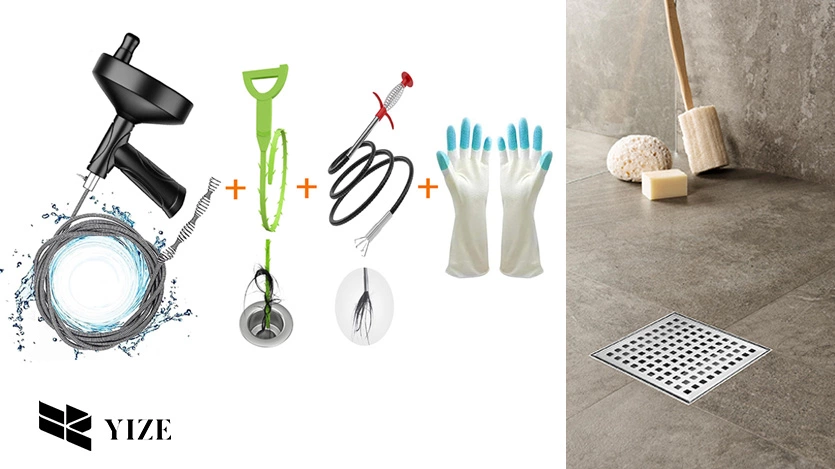
I. Introduction
It is highly important that your linear shower drain is maintained clean if you are to use your shower effectively. Periodically, hair, soap scum, and other particles can accumulate thus causing blockage and a bad smell. In this article, we’ll elucidate on how to clean your linear shower drain properly in a much more comprehensive manner. Following those eight easy steps will help you keep the drain free of any difficult, working, and clean.
II. Clean Your Linear Shower Drain Like a Pro: Step-by-Step Instructions
Regular cleaning of your linear shower drain is necessary to prevent obstructions, bad odours, and damage. When a drain is clean, water flows through it easily and without obstructions that could result in blockages and more complex plumbing problems. Discover how to clean your linear shower drain quickly and effectively with these 8 close-up steps in this to offer.
III. Step-by-Step Cleaning Guide

1. Step 1: Collect All the Necessary Supplies
●The first preparation process involves the collection of all the materials required during the procedure.
●Ensure all preparation is in place before beginning. Here’s a list of essential items you’ll need:
●Cleaning gloves of various types serves to protect our hands.
●A bottle of drain cleaner (though ideally an environmentally friendly one)
●A scrub brush or an old toothbrush
●Tweezers or a small brush for removing debris
●Hot water for rinsing
●A screwdriver (if need to remove the drain cover)
This way, when cleaning, all the supplies will be around and this will not require one to stop mid-way because some of the tools are missing.
2. Step 2: Spray and Clean the Tile Insert
First, you will need to take out the tile insert from the linear shower drain you are working on. This part sometimes collects soap scum and other residue which may need thorough washing. Apply the cleaner of your choice on the tile insert and let it stand for about five to ten minutes before scrubbing. Clean it gently with a soft brush or a sponge, and ensure all the corners are cleaned well. This is perhaps due to the usage of hard or rough surface cleaners that may scratch the tile surface.
3. Step 3: Remove the Drain Cover
Then, cautiously lift the drain cover. In this step, you may require a screwdriver to do this depending on the type of linear drain you intend to fit. It is important to adhere to the manufacturer’s guidelines for installation to ensure that there is no damage when you are removing the panels. However, if you are in doubt as to how to safely remove the cover, check the product manual.
4. Step 4: Remove Any Visible Debris
This will require the removal of all the visible debris once the drain cover has been pulled off. This entails, hair, soap scum, and other debris that may have accumulated in the drain. You can use tweezers or a small brush to gently clean the debris off the contacts. For areas that are hard to reach such as the corners of the drain, using a thin brush is very appropriate. Frequent clearance of the debris will help to avoid formation of serious blockages in the pipeline.
5. Step 5: Apply Drain Cleaner
Stir to clear a blockage, and if there is dirt then you should apply the right drain cleaner. Select a drain cleaner that is suitable for the linear shower drain and one that is free from chemicals that may harm the drain parts. When using the cleaner, make sure to read and follow all the instructions written on the container. Give the cleaner time to do the job and let it sit for the required time to dissolve any deposits that may be within the drain line.
6. Step 6: Scrub the Drain
With the help of a scrub brush or toothbrush, clean the inner surface of the drain vigorously. Concentrate on eradicating further deposit or dirt from the interior walls and margins of the drain. When cleaning the drain do it gently but with a considerable amount of pressure so as to remove as much dirt as possible without damaging the drain. You can also use a small brush that you can insert deep into the interior of the drain.
7. Step 7: Rinse the drain
After you have finished cleaning your drain, you should rinse it with hot water to remove every trace of the cleaner and gunk. It is advisable to pour the hot water slowly to so as to make sure that it washes through the drain. This step is crucial in ensuring that the cleaner residue does not accumulate and lead to future or more severe blockages.
8. Step 8: Replace the Drain Cover and Tile Insert
When washing everything is washed and rinsed, fit the drain cover and tile insert back into place. Check that they are well positioned and firmly fastened. Ensure that all the components fit appropriately and that the drain cover is not damaged or wobbly. Everything is now set and you were able to clean your linear shower drain efficiently.
IV. How Often Should You Clean a Linear Shower Drain?

After a month or two, you should clean your linear shower drain to improve its function. However, this could change based on things like how many people are using the shower, what kind of hair is being washed, and other elements that might become stuck in the wash. Your drain is clogged and needs to be cleaned if you notice that water drains slowly or has an unpleasant odour.
V. How Do You Keep Your Hair from Clogging in a Linear Drain?
As linear drains can easily be clogged, especially by hair, you can use hair catcher or hook-like drain cover that helps to pin the hair before it falls on the drain. Cleaning your drains from any hair that could be seen after taking a shower also plays a vital role in avoiding blockages. Regular cleaning of your drain and acquiring of preventive tools will help avoid such incidences of blockages.
Are There Specific Brands Recommended for Linear Shower Drains?
It is also crucial to consider the brand of the linear shower drains, for instance YZDRAIN is a reputable brand known for its strong construction and design. They are easy to clean and maintain and this makes them to be preferred most especially by the homeowners. It is important to clean the drain according to the manufacturer’s guidelines to prevent damaging the drain.
VI. Conclusion
It is not a hard task to clean your linear shower drain, but the information above should help those who find themselves struggling with the process. You can practice these eight easy measures to avoid blockage and keep your drain working effectively. It is advised that showers should be cleaned often and that prior methods of preventing shower drain backlog such as using hair catcher will assist in achieving this. By following this cleaning schedule, you will have a cleaner shower that will drain properly and will not have any bad smell.
FAQs
1. How often should I clean my linear shower drain?
It is recommended to clean your drain every 1-2 months or when you recognize slow drain or foul smell.
2. What tools do I need to clean a linear shower drain?
You will require cleaning gloves, a drain cleaner, a scrub brush, a pair of tweezers, and hot water.
3. Can I use any drain cleaner on my linear drain?
There are some drain cleaners that are not safe for certain types of drain material, therefore, it is advisable to work with the instructions provided when using a cleaner.

